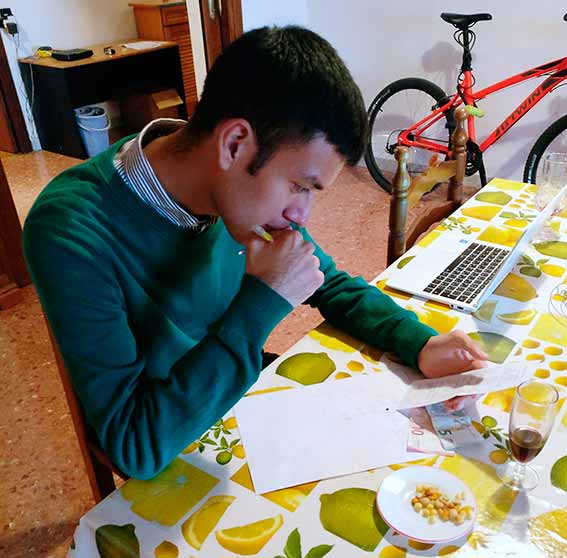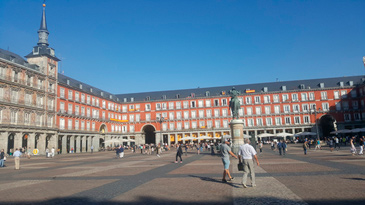One of the biggest worries when moving to a new country is how far your money will go. Will you need to find a part-time job? Will you be able to travel? Those are some questions I asked myself when considering the cost of living in Spain.
The Cost of Living in Spain Compared to Other Countries: Main Expenses
One year after graduating from Fontbonne University, I made the decision to leave the US and fulfill my dream of living abroad. I spent the next three years in Japan before making my way over to Spain. Although the initial knowledge of receiving less money than what I was receiving in Asia was a bit of a bummer (keep in mind the Meddeas grant is quite good compared to what beginner teachers in Spain make), I didn’t realize how much cheaper things would be in Spain. When comparing the cost of living in Spain vs USA or even Japan, you realize the first is much lower. Even in Cataluña, which is not the cheapest place to live in Spain as things tend to be more expensive than in other Spanish regions, the grant has been plenty for living comfortably and being able to go out enjoy myself.

How Much Does it Cost to Live in Spain? Looking Prices Over
The three main things I will be speaking about to describe the cost of living in Spain are housing, travel, and food. I’m teaching in a school in Lleida, a medium size city in Cataluña with 140,000 inhabitants. Thus, prices here refer to life in a smaller city, in an independent living situation.
Housing Information for Expats in Spain
Housing is an important thing to consider because this will be your home for the next year. I was lucky enough to make friends with people who had also just arrived in our city. After two weeks searching, we managed to find a wonderful place and even managed to haggle the price down an additional €50. My three flatmates and I each pay €175 with approximately €30 for utilities. Of course, keep in mind that this is in a smaller city. A small or medium size could be considered the best cities to live in Spain in terms of expenses.

In a larger city, expect to pay twice or even three times more for a shared flat. If you’re living on your own in a similarly sized city, you could expect to be paying €300+ for a one person flat. Although I had previously been living on my own in Japan and loved the privacy, I would highly recommend sharing a flat. Otherwise, you will be spending a half of your grant on housing alone.
Some numbers to show the cost of living in Spain when talking about housing:
Internet – €10*
Utilities – €30*
Rent – €175 a month*
*per person (4 people total)
(Approximately 20% of the Meddeas grant)
Travel: How Expensive is Spain?
There are many means of travel within Spain. Public transport can vary greatly between cities. I typically use the bus to move between work and school a few times a week and the price is standard across bus usage in the city.
On the weekends I tend to travel. So I’m always looking for the most convenient and efficient way to go. Low-cost travel in Spain is possible. If you shop early enough you can usually find a deal on high-speed trains. However, this isn’t always the best method of travel as it’s expensive and the lines aren’t always well connected. For example, when I wanted to go to Valencia I would first have to travel to Barcelona then take the train to Valencia. This is where Blablacar is a better option.

Blablacar is a ride-sharing service for people traveling between cities. You share a car with multiple people and pricing is affordable. You should consider the price and time spent in commute between Blablacar and the high-speed train. For me, I save around €25 taking a Blablacar to Barcelona and only take 45 minutes longer. But, for a trip to Madrid, I would save €50 but at the expense of spending 3 extra hours in commute. In the latter case, spending a bit more is worth it for me to have extra time in the city.
Some numbers to show how much it costs me to travel from and inside Lleida:
Bus fare – €2 a trip (€24 for monthly pass)
High-Speed Train to Barcelona- ~€37 – €43
High-Speed Train to Madrid ~€73 – €100
Blablacar to Barcelona – €11
Blablacar to Madrid – €28
Food: Prices According to the Standard of Living in Spain
I lucked out that both breakfast and lunch are provided at my school at no cost (don’t you expect this to happen in your school, it is an exceptional situation). Dinner is also something that I worry little about since my three flatmates and I cook together. If you’re looking to save money then making a floor fund is the method I recommend. Every week my flatmates and I put around €10-20 into the fund for groceries. These €40-80 go a long way at the grocery store towards buying food for the week. Since we cook together, we are able to make large batches of food that will last us at least a couple of meals.

Cost of Groceries
I’ve found the cost of groceries in Spain to be more affordable than those in the US and Japan. However, some items like meat tend to cost more than back home. It also helps that, since the portion sizes are smaller, here we generally don’t need to buy as much.
Some examples of things we frequently buy, which clearly reflect the cost of living in Spain, include:
Oranges/Bananas – €1 / kilogram
Coca-Cola – €0.76 / 2 liter bottle
Bottle of Wine – €1.50 – €7 (average around €2.50)
Milk – €0.80 / liter
Yogurt – €1.20 (pack of 6)
Ground Coffee – €4.76 / kilogram (2 pack = 250 grams = €1.20)
Freshly Baked Baguette – €1.73 / kilogram (3 Baguettes = 1 kilogram)
Eggs – €1.35 / dozen
When it comes to food, the worst thing you can do is continue to eat like back home. The most cost-effective way is to live like a local. You’ll save a lot of money in the long run. My roommates and I decided to have a Mexican food night once. Hunting down the ingredients necessary for some traditional Mexican meals, led to a lot of headaches and spending more than we had hoped. Although it’s nice to have a taste of home, it is far too much work and not economical when the ingredients are not readily available.
Cost of Going out with Friends: Drink and Tapas
Of course, I can’t leave out my favorite part of living in Spain: going out with friends for drink and tapas. The price of beer is cheaper here than back home in the US and, with no tipping necessary, we can go out a few times a week without breaking the bank.
Beer – €1-€1.50
Tapas – €1-€3
These are just some examples to show the cost of living in Spain when it comes to basic necessities. The rest will vary from person to person. Some of you may be fans of shopping, I personally am not. But I seem to find that clothes are cheaper or similar priced as back home. In terms of buying electronics, they tend to be more expensive in Spain. Other than that, it’s all about budgeting and prioritizing your expenses.

Some things will be consistent, like housing expenses (be wary of heating costs in the wintertime!) and groceries, if you typically buy the same things a week. Others will vary greatly, such as going out to eat or traveling to another country. Bear in mind that, when talking about the cost of living in Europe, there are huge differences between countries.
Money Saving Tips Regarding the Cost of Living in Spain
- Share a flat with others your age. It’s a great way to save money and be sociable.
- Make a floor fund with flatmates so buy larger quantities of groceries (potatoes, tomatoes, bread).
- Eat like the locals. Don’t eat like back home.
- Start out conservatively the first few months. See what can be cut and what you can afford to do.
- Use Blablacar. If you make frequent trips to certain cities, ask the driver or fellow riders if they are part of a Whatsapp/Facebook group of people that travel between your city and that city. You could be saving money by contacting drivers directly.
Definitely, keep track the first few months and see where you can cut costs. The first two months or so will be an adventure in learning how to live and what to buy. Thus, shop around with some friends who have more experience living in your region and you’ll have lots of advice for living affordably. All in all the Meddeas grant is enough to cover housing, travel, and still have extra to go out and do things.
The Cost of Living in Big Cities in Spain is Higher: Madrid, by Nicole G.
I expected to find the cost of living in Spain around the same as at home. However, it’s been surprisingly affordable considering that Madrid, where I’m placed, is supposedly the most expensive city in Spain. It turns out that Bristol is the 16th most expensive city in the whole of Europe and probably with good reason. Let’s compare some prices.

Rent in the UK Compared to Spain
In Bristol, I paid £450 (€502.77) a month including bills for a double bedroom Monday to Friday in a three-bedroom house. The landlord would return at the weekend, at which point I needed to vacate and return to my parents’ house. Therefore, I also needed to pay £16 (€18) a week for travel there and back. We had a cleaner visit once every 2 weeks included with the rent.
In Madrid, I pay €424 a month for a single bedroom in a 7 bedroom apartment. It’s all inclusive of bills and the apartment is set out in a university housing style with no shared living room. However, the room is quite large and I have a sofa, a TV, a large fridge, and all furnishings (also bedding) included in the price. We have a cleaner who comes once a week and even changes my bed sheets, so I think this is definitely a good value for money.
Public Transport in Madrid
The public transport system in Bristol is okay, but it’s certainly not up to Madrid standards. As a result, if I found myself running late for something and I needed to get there urgently, I had to shell out for Uber’s a few times a month which definitely bumped up what I would pay for transport. Aside from that, I paid £48 (€55) a month for a bus pass.
In comparison, in Madrid, I buy the tarjeta de transporte público and top this up once a month for €20. The card lasts for 30 days for unlimited trips on the metro and on the buses. The public transport runs frequently and on time here (and runs until 2 am!), so I haven’t needed to take any taxis yet. Madrid definitely beats Bristol here with a massive €100 a month saving.
Cost of Food in Madrid
Food is probably where I’ve seen the least difference in expense between the UK and Spain, but that’s not to say I don’t still save considerably. In Bristol, there are big supermarkets all over the city. However, in Madrid, you need to travel out of the city to find the bigger markets. When I first moved to Madrid, I assumed that this meant the food was going to be more expensive, (fellow Brits think Co-op or Spa prices!) but I’ve been pleasantly surprised.

Bread, Soy Milk
In Madrid, bread costs me approximately €0.83 compared to around 85p (€0.95) in the UK. A liter of Soy Milk costs me around £1.70 (2.02€), compared to around 1.60€ in Madrid. In total, I spent around 15€ a week on groceries in Madrid compared to about £20 (€23) a week in Bristol. My favorite saving, however, has got to be on a bottle of red wine. A cheap bottle of wine in the UK costs around £5 (€7), whereas I can find an equally good bottle of wine for around 2€ in Spain.
Bars and tapas
In a bar in Madrid, a glass of wine costs anywhere from €1-€3. The more touristic the bar, the more expensive the wine, but it’s always generally quite cheap compared to what I’m used to. Also, when you order a drink in Spain you get tapas for free, which saves some money compared to the snacks you end up buying in the UK.
¡Viva España!
To sum up, everything in Spain just seems cheaper than it was in the UK. I’m earning a little less than I would have been in the UK, but my money goes a lot further and I don’t find living in Spain any more expensive. In short, living in Madrid has been cheaper for me than living at home in the UK. On the Meddeas grant, I can live comfortably and travel, which is something I likely not be able to do at home on the same wage. ¡Viva España!












17 Responses
The price breakdowns in this post are awesome! I chose to live with a host family, so I do not have to stress about rent or food, but my stipend is also less and I also have several other obligations included as being part of a family here. The stipend that you receive from Meddeas easily covers all of the expenses you should have. However, if you are planning to come to Spain and travel to other countries while you’re here, I highly recommend saving up some money before you come to use for travelling. Most of your stipend will be spent on outings with friends and other necessities within the city you’re living in. I have also used some of my stipend for weekend trips within Spain you just have to know how to travel on the cheaper side by using BlaBla car and staying in hostels instead of hotels!
I am currently living in Murcia and I’ve found the cost of living here to be really affordable. I live with a host family so I don’t have to worry about costs on rent and food at all. My host mom makes sure I have breakfast, lunch, and dinner as well as fruits and other tasty snacks (like biscotto). From time to time, I will spend money on things like clothes or trips around the country and Europe, but other than that my expenses are limited. While you can find rent in Madrid to be cheap, Murcia is much cheaper than most cities. Rent here runs about 200-300 a month and some places are as low as 180 euros! The city is also easily accessible by foot so paying for public transport hasn’t been necessary. All in all, Murcia is a great city to live in without spending a fortune 🙂
Really informative post! The hard thing is that everywhere you’re based will be completely different cost-wise…I’m based in a very small but VERY touristy area, so it can be really expensive to live. My biggest tip – don’t go out through the week, and buy groceries in bulk to cook one big meal to eat for dinners through the week. That allows me to have a splurge on the weekend!!
I am living with a host family through Meddeas so I find that there are weeks where I am not even needing to spend any money because my housing is covered and my host family helps to provide access to food for my meals during the week. The stipend for those living with a host family is lower than those living independently for this reason. Times when I do spend my own money to eat out or to buy a special treat I find like mentioned in these two articles that everything is very affordable. I live in Murcia, which is a city, but the center is very easy to access by walking, so I’ve also saved a lot of money on public transportation by being able to get around on foot instead! I enjoyed being able to see price breakdowns of expenses to know for the future if I end up living independently here in Spain!
Very informative post for people wandering about the cost of living!
I absolutely love the quality of life I can have in Spain on my paycheck! On a similar paycheck in the UK, I would just be able to afford rent, bills and commuting to work. In the year and a half I have been in Spain I have managed to travel to 9 new countries, COUNTLESS new cities all over Spain, have the best social life (and food) ever and still have money to spare.
There is nothing that I rave about more here than the Metro in Madrid. I pay 20euros/month to go what seems like anywhere in the city. Further, I am in constant shock at the cost differences in housing here. At home in Philadelphia, my rent (in one of the poorer areas of the city) was $590/month not including WiFi or utilities. Meanwhile, something here could be anywhere from 350euros – 500 euros, often with “gastos” included. I’ve also found that many people might find a place and then switch halfway through the year. Nothing is set in stone. You can always readjust your budget.
Totally agree with eating like the locals! I make tortilla de patatas every week haha and super cheap!!!
I am currently living in Burgos, a small Northern city with about 180,000 inhabitants. I have found the rent and lifestyle here so affordable, especially when compared to prices from home! I live in the city centre so very rarely find a bus. One thing that I have found to be more expensive here is a gym membership. The gyms here are more expensive than home and usually operate on Spanish time, so they close for siestas or dont open on Sundays, which is inconvenient if you are too busy to go during the week!
Yes to all this information, blah blah car is such a lifesaver! I pay a very similar amount for my rent and utilities and I feel very grateful that this country is so affordable. Living in a smaller town does help with expenses but of course traveling isn’t too expensive here as well. Thanks for this budgeting tips, i can’t wait to make the most of the rest of my time here with these ideas in mind!
I think providing both the pueblo and big city perspective was great! Even though Spain is cheap in general, big cities are still much more expensive to live in than pueblos. I agree that Madrid was quite a surprise to me because I had come from Toledo where I was paying 250 euros a month for a two-bedroom apartment, and then went to Madrid and was paying 495 for a four-bedroom! It’s crazy the difference, but Madrid definitely has its perks!
Really informative article about the price of living in Spain. I agree that it is affordable with the grant. I live in a medium sized city in the north of Spain (Logroño, capital of La Rioja) and pay around 200 euro for rent in a shared flat with 2 others. Besides internet, all of the expenses are included. This is so cheap compared to where I’m from in Ireland. Travelling is affordable in my city (the shuttle buses are only 72 cents and less if you have a card) and bus/train tickets can be found at a good price in advance. Blabla car was a good suggestion also! Eating out for tapas can be cheap. On Thursdays we have pinchato (pinchos and wine for 2 euro) and it’s normal for people to put in 10 euro and go to a few places. Overall, it is possible to live here with the grant and can also save if you budget and find ways to cut costs, like sharing dinners and cost of grocery shopping (great idea!)
I’m living in Madrid too and I agree that one of the biggest savings is on transport! I love my public transport card. It covers my commute and it also encourages me to travel around the outskirts of Madrid a little more, as the train, bus and metro are all included! It saves me a fortune. Thanks for breaking everything down and sharing your tips!
This is great! I wish my rent was €175 in Barcelona But very cool about blablacar! I’ve never used it, but looking at those prices, I’m going to check it out!
I’m in Bilbao and I spend just about all my grant each month. 350 on rent and utilities and then the majority of the rest on my constant craving for food!
I really like how you’ve split up all the costs and made everything transparent. It really helps people who are considering taking a placement to make their decision!
I live in Madrid, so I can confirm that what Nicole has said here is all really accurate! With flats in Madrid you should be prepared for a competitive search as there are always many people looking for a place. That being said, its good to have an idea of what you’re looking for and the price you’re willing to pay! I made a mistake with that as I wanted to share only with one or two people but I didn’t want to pay over 400 euros which is difficult in Madrid. If you’re willing to share with more people then it opens up a lot more options since there are loads of flats with as many as 10 rooms!
Thanks for all the advice!
Hannah
I agree! Same in Barcelona. You’re still likely to pay maybe €300-€450 even if you’re sharing with 6 or more people. It’s crazy, but sometimes you’re lucky and can find a better option for a similar price.